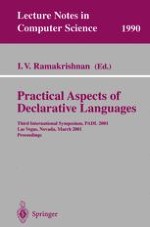2001 | Buch
Practical Aspects of Declarative Languages
Third International Symposium, PADL 2001 Las Vegas, Nevada, March 11–12, 2001 Proceedings
herausgegeben von: I. V. Ramakrishnan
Verlag: Springer Berlin Heidelberg
Buchreihe : Lecture Notes in Computer Science
Enthalten in: Professional Book Archive
